Suitability Assessment of Six Tree Species through Combined Analysis of PM2.5 Capture Ability and Air Pollution Tolerance Index for Urban Green Belt
Abstract
:1. Introduction
2. Methods
2.1. Study Sites
2.2. Leaf Sample Collection
2.3. Amount of PM2.5 on Leaves
2.4. Leaf Microstructures
2.4.1. Leaf Surface Roughness
2.4.2. Contact Angle
2.4.3. Stomatal Density and Groove Width
2.5. Biochemical Parameters
2.5.1. Relative water content (RWC)
2.5.2. pH of Leaf Extract (pH)
2.5.3. Ascorbic Acid Content (AAC)
2.5.4. Total Chlorophyll Content (TCC)
2.6. Air Pollution Tolerance Index (APTI)
2.7. New Anticipated Performance Index (NAPI)
2.8. Statistical Analysis
3. Results
3.1. The Captured PM2.5 Amounts of the Tested Tree Species
3.2. Relationship between Leaf Traits and PM2.5 Capture Ability
3.3. Biochemical Parameters of Each Species
3.4. Differences in APTI Values
3.5. Relationship between APTI and PM2.5
4. Discussion
4.1. PM2.5 Retention Ability between Tested Species
4.2. Effect of Biochemical Characteristics on APTI
4.3. Impact of PM2.5 Capture Ability on NAPI
4.4. Limitations and Future Directions
5. Conclusions
Supplementary Materials
Author Contributions
Funding
Institutional Review Board Statement
Informed Consent Statement
Data Availability Statement
Conflicts of Interest
References
- Alotaibi, M.D.; Alharbi, B.H.; Al-Shamsi, M.A.; Alshahrani, T.S.; Al-Namazi, A.A.; Alharbi, S.F.; Alotaibi, F.S.; Qian, Y. Assessing the response of five tree species to air pollution in Riyadh City, Saudi Arabia, for potential green belt application. Environ. Sci. Pollut. Res. Int. 2020, 27, 29156–29170. [Google Scholar] [CrossRef] [PubMed]
- He, C.; Qiu, K.; Pott, R. Reduction of urban traffic-related particulate matter-leaf trait matters. Environ. Sci. Pollut. Res. Int. 2020, 27, 5825–5844. [Google Scholar] [CrossRef]
- Zhang, Z.; Gong, J.; Li, Y.; Zhang, W.; Zhang, T.; Meng, H.; Liu, X. Analysis of the influencing factors of atmospheric particulate matter accumulation on coniferous species: Measurement methods, pollution level, and leaf traits. Environ. Sci. Pollut. Res. Int. 2022, 29, 62299–62311. [Google Scholar] [CrossRef]
- Rai, P.K. Impacts of particulate matter pollution on plants: Implications for environmental biomonitoring. Ecotoxicol. Environ. Saf. 2016, 129, 120–136. [Google Scholar] [CrossRef] [PubMed]
- Nowak, D.J.; Hirabayashi, S.; Bodine, A.; Hoehn, R. Modeled PM2.5 removal by trees in ten U.S. cities and associated health effects. Environ. Pollut. 2013, 178, 395–402. [Google Scholar] [CrossRef] [PubMed]
- Pandey, A.K.; Pandey, M.; Mishra, A.; Tiwary, S.M.; Tripathi, B.D. Air pollution tolerance index and anticipated performance index of some plant species for development of urban forest. Urban For. Urban Green. 2015, 14, 866–871. [Google Scholar] [CrossRef]
- Guarnieri, M.; Balmes, J.R. Outdoor air pollution and asthma. Lancet 2014, 383, 1581–1592. [Google Scholar] [CrossRef] [PubMed]
- Lelieveld, J.; Evans, J.S.; Fnais, M.; Giannadaki, D.; Pozzer, A. The contribution of outdoor air pollution sources to premature mortality on a global scale. Nature 2015, 525, 367–371. [Google Scholar] [CrossRef] [PubMed]
- Kapoor, C.S.; Bamniya, B.R.; Kapoor, K. Efficient control of air pollution through plants, a cost-effective alternative: Studies on Dalbergia sissoo Roxb. Environ. Monit Assess 2013, 185, 7565–7580. [Google Scholar] [CrossRef]
- Prajapati, S.K.; Tripathi, B.D. Anticipated Performance Index of some tree species considered for green belt development in and around an urban area: A case study of Varanasi city, India. J. Environ. Manag. 2008, 88, 1343–1349. [Google Scholar] [CrossRef]
- Tong, Z.; Baldauf, R.W.; Isakov, V.; Deshmukh, P.; Zhang, K.M. Roadside vegetation barrier designs to mitigate near-road air pollution impacts. Sci. Total Environ. 2016, 541, 920–927. [Google Scholar] [CrossRef]
- Dzierzanowski, K.; Popek, R.; Gawronska, H.; Saebo, A.; Gawronski, S.W. Deposition of particulate matter of different size fractions on leaf surfaces and in waxes of urban forest species. Int. J. Phytoremediat. 2011, 13, 1037–1046. [Google Scholar] [CrossRef]
- Vigevani, I.; Corsini, D.; Mori, J.; Pasquinelli, A.; Gibin, M.; Comin, S.; Szwałko, P.; Cagnolati, E.; Ferrini, F.; Fini, A. Particulate Pollution Capture by Seventeen Woody Species Growing in Parks or along Roads in Two European Cities. Sustainability 2022, 14, 1113. [Google Scholar] [CrossRef]
- Li, Y.; Zhang, X.; Li, M.; Yin, S.; Zhang, Z.; Zhang, T.; Meng, H.; Gong, J.; Zhang, W. Particle resuspension from leaf surfaces: Effect of species, leaf traits and wind speed. Urban For. Urban Green. 2022, 77, 127740. [Google Scholar] [CrossRef]
- Chávez-García, E.; González-Méndez, B. Particulate matter and foliar retention: Current knowledge and implications for urban greening. Air Qual. Atmos. Health 2021, 14, 1433–1454. [Google Scholar] [CrossRef]
- Rai, P.K.; Panda, L.L.S. Dust capturing potential and air pollution tolerance index (APTI) of some road side tree vegetation in Aizawl, Mizoram, India: An Indo-Burma hot spot region. Air Qual. Atmos. Health 2014, 7, 93–101. [Google Scholar] [CrossRef]
- Gupta, G.P.; Kumar, B.; Kulshrestha, U.C. Impact and pollution indices of urban dust on selected plant species for green belt development: Mitigation of the air pollution in NCR Delhi, India. Arab. J. Geosci. 2016, 9, 1–15. [Google Scholar] [CrossRef]
- Banerjee, S.; Banerjee, A.; Palit, D. Morphological and biochemical study of plant species- a quick tool for assessing the impact of air pollution. J. Clean. Prod. 2022, 339, 130647. [Google Scholar] [CrossRef]
- Bui, H.-T.; Odsuren, U.; Kwon, K.-J.; Kim, S.-Y.; Yang, J.-C.; Jeong, N.-R.; Park, B.-J. Assessment of Air Pollution Tolerance and Particulate Matter Accumulation of 11 Woody Plant Species. Atmosphere 2021, 12, 1067. [Google Scholar] [CrossRef]
- Popek, R.; Przybysz, A.; Gawrońska, H.; Klamkowski, K.; Gawroński, S.W. Impact of particulate matter accumulation on the photosynthetic apparatus of roadside woody plants growing in the urban conditions. Ecotoxicol. Environ. Saf. 2018, 163, 56–62. [Google Scholar] [CrossRef]
- Masuch, G.; Kicinski, H.G.; Kettrup, A.; Boos, K.S. Single and Combined Effects of Continuous and Discontinuous O3 and SO2 Immission on Norway Spruce Needles: I. Histological and Cytological Changes. Int. J. Environ. Anal. Chem. 1988, 32, 187–212. [Google Scholar] [CrossRef]
- Giri, S.; Shrivastava, D.; Deshmukh, K.; Dubey, P. Effect of Air Pollution on Chlorophyll Content of Leaves. Curr. Agric. Res. J. 2013, 1, 93–98. [Google Scholar] [CrossRef]
- Simon, E.; Molnar, V.E.; Lajtos, D.; Bibi, D.; Tothmeresz, B.; Szabo, S. Usefulness of Tree Species as Urban Health Indicators. Plants 2021, 10, 2797. [Google Scholar] [CrossRef] [PubMed]
- Correa-Ochoa, M.; Mejia-Sepulveda, J.; Saldarriaga-Molina, J.; Castro-Jimenez, C.; Aguiar-Gil, D. Evaluation of air pollution tolerance index and anticipated performance index of six plant species, in an urban tropical valley: Medellin, Colombia. Environ. Sci. Pollut Res. Int. 2021, 29, 7952–7971. [Google Scholar] [CrossRef]
- Kaur, M.; Nagpal, A.K. Evaluation of air pollution tolerance index and anticipated performance index of plants and their application in development of green space along the urban areas. Environ. Sci. Pollut Res. Int. 2017, 24, 18881–18895. [Google Scholar] [CrossRef]
- Roy, A.; Bhattacharya, T.; Kumari, M. Air pollution tolerance, metal accumulation and dust capturing capacity of common tropical trees in commercial and industrial sites. Sci. Total Environ. 2020, 722, 137622. [Google Scholar] [CrossRef]
- Singh, S.K.; Rao, D.N.; Agrawal, M.; Pandey, J.; Naryan, D. Air pollution tolerance index of plants. J. Environ. Manag. 1991, 32, 45–55. [Google Scholar] [CrossRef]
- Ogunkunle, C.O.; Suleiman, L.B.; Oyedeji, S.; Awotoye, O.O.; Fatoba, P.O. Assessing the air pollution tolerance index and anticipated performance index of some tree species for biomonitoring environmental health. Agrofor. Syst. 2015, 89, 447–454. [Google Scholar] [CrossRef]
- Beckett, K.P.; Freer-Smith, P.; Taylor, G. Particulate pollution capture by urban trees: Effect of species and windspeed. Glob. Change Biol. 2000, 6, 995–1003. [Google Scholar] [CrossRef]
- Han, Y.; Lee, J.; Haiping, G.; Kim, K.-H.; Wanxi, P.; Bhardwaj, N.; Oh, J.-M.; Brown, R.J.C. Plant-based remediation of air pollution: A review. J. Environ. Manag. 2022, 301, 113860. [Google Scholar] [CrossRef]
- Xu, X.; Xia, J.; Gao, Y.; Zheng, W. Additional focus on particulate matter wash-off events from leaves is required: A review of studies of urban plants used to reduce airborne particulate matter pollution. Urban For. Urban Green. 2020, 48, 126559. [Google Scholar] [CrossRef]
- Weerakkody, U.; Dover, J.W.; Mitchell, P.; Reiling, K. Evaluating the impact of individual leaf traits on atmospheric particulate matter accumulation using natural and synthetic leaves. Urban For. Urban Green. 2018, 30, 98–107. [Google Scholar] [CrossRef]
- Wang, H.; Shi, H. Particle Retention Capacity, Efficiency, and Mechanism of Selected Plant Species: Implications for Urban Planting for Improving Urban Air Quality. Plants 2021, 10, 2109. [Google Scholar] [CrossRef]
- Wang, H.; Xing, Y.; Yang, J.; Xie, B.; Shi, H.; Wang, Y. The Nature and Size Fractions of Particulate Matter Deposited on Leaves of Four Tree Species in Beijing, China. Forests 2022, 13, 316. [Google Scholar] [CrossRef]
- Molnar, V.E.; Tozser, D.; Szabo, S.; Tothmeresz, B.; Simon, E. Use of Leaves as Bioindicator to Assess Air Pollution Based on Composite Proxy Measure (APTI), Dust Amount and Elemental Concentration of Metals. Plants 2020, 9, 1743. [Google Scholar] [CrossRef]
- Janhäll, S. Review on urban vegetation and particle air pollution–Deposition and dispersion. Atmos. Environ. 2015, 105, 130–137. [Google Scholar] [CrossRef]
- Li, Y.; Wang, S.; Chen, Q. Potential of Thirteen Urban Greening Plants to Capture Particulate Matter on Leaf Surfaces across Three Levels of Ambient Atmospheric Pollution. Int. J. Environ. Res. Public Health 2019, 16, 402. [Google Scholar] [CrossRef]
- Pandey, J.; Agrawal, M. Evaluation of air pollution phytotoxicity in a seasonally dry tropical urban environment using three woody perennials. New Phytol. 1994, 126, 53–61. [Google Scholar] [CrossRef]
- Zhang, W.; Zhang, Y.; Gong, J.; Yang, B.; Zhang, Z.; Wang, B.; Zhu, C.; Shi, J.; Yue, K. Comparison of the suitability of plant species for greenbelt construction based on particulate matter capture capacity, air pollution tolerance index, and antioxidant system. Environ. Pollut. 2020, 263, 114615. [Google Scholar] [CrossRef]
- Keller, T.; Schwager, H. Air pollution and ascorbic acid. Eur. J. For. Pathol. 1977, 7, 338–350. [Google Scholar] [CrossRef]
- Malav, L.C.; Kumar, S.; Islam, S.; Chaudhary, P.; Khan, S.A. Assessing the environmental impact of air pollution on crops by monitoring air pollution tolerance index (APTI) and anticipated performance index (API). Environ. Sci. Pollut Res. Int. 2022, 29, 50427–50442. [Google Scholar] [CrossRef] [PubMed]
- Singh, S.; Verma, A. Phytoremediation of air pollutants: A review. In Environmental Bioremediation Technologies; Springer: Berlin/Heidelberg, Germany, 2007; pp. 293–314. [Google Scholar] [CrossRef]
- Singh, S.; Pandey, B.; Roy, L.B.; Shekhar, S.; Singh, R.K. Tree responses to foliar dust deposition and gradient of air pollution around opencast coal mines of Jharia coalfield, India: Gas exchange, antioxidative potential and tolerance level. Environ. Sci. Pollut Res. Int. 2021, 28, 8637–8651. [Google Scholar] [CrossRef] [PubMed]
- Thompson, J.E. Airborne Particulate Matter. J. Occup. Environ. Med. 2018, 60, 392–423. [Google Scholar] [CrossRef] [PubMed]

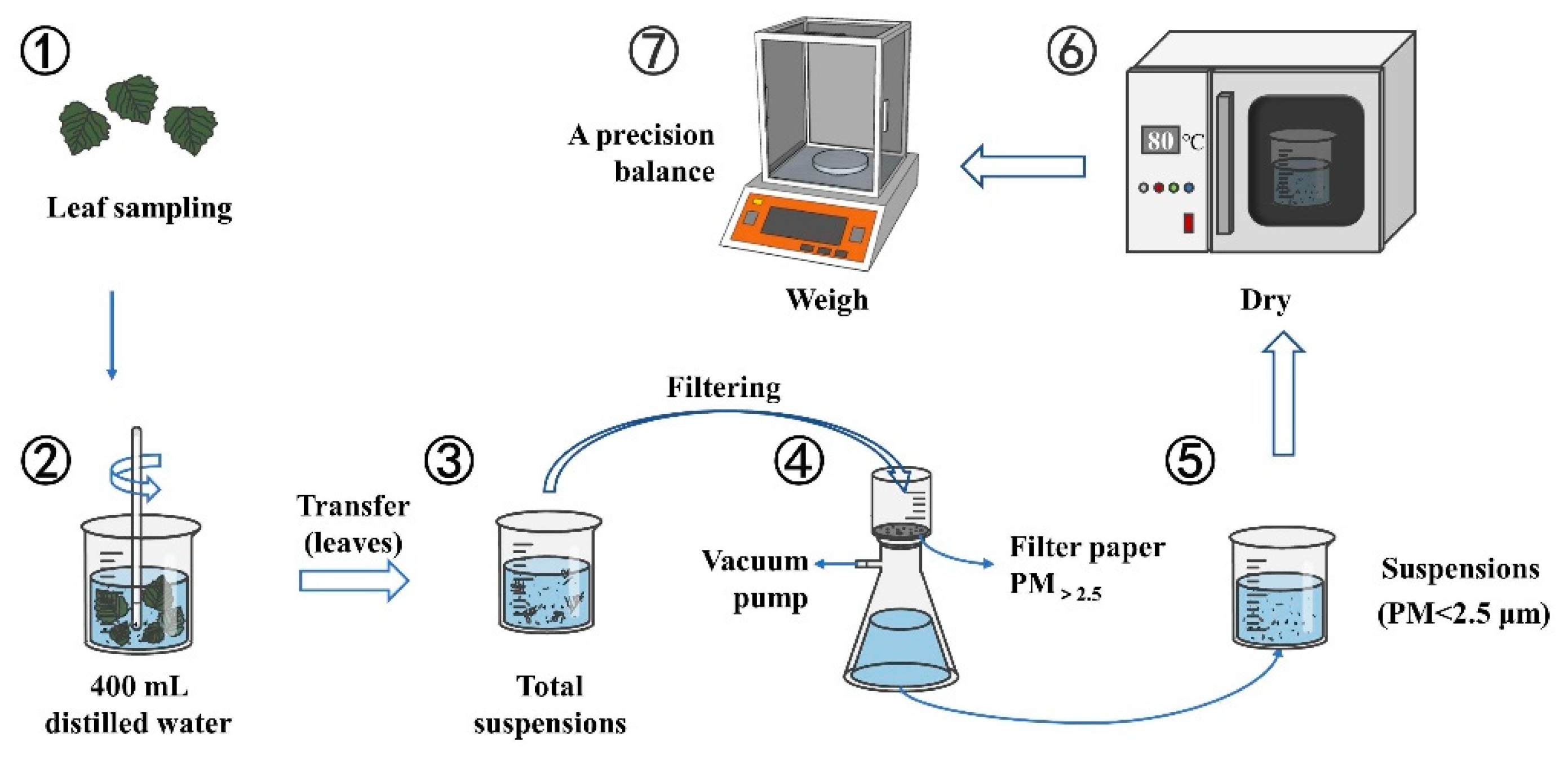
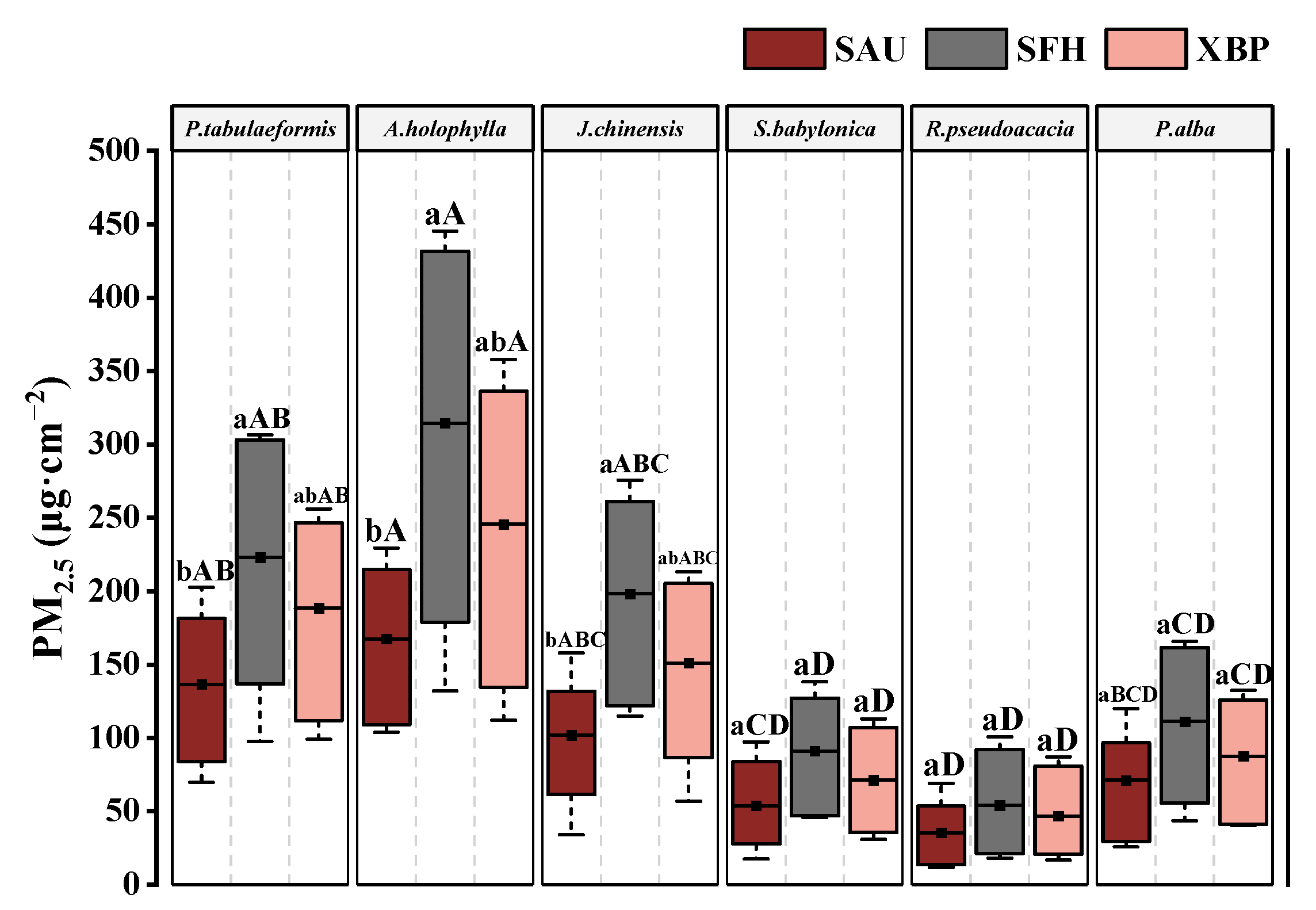
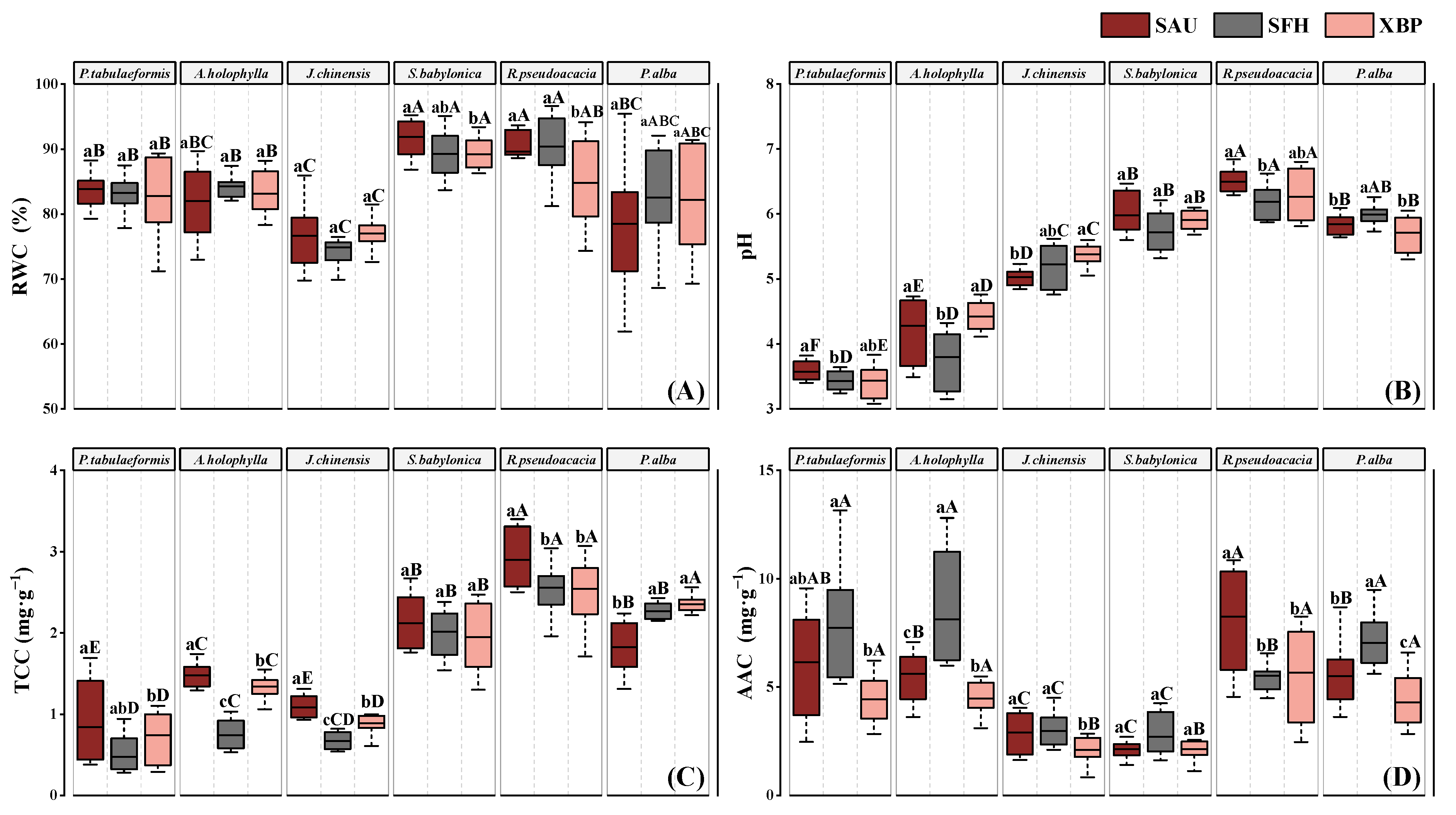
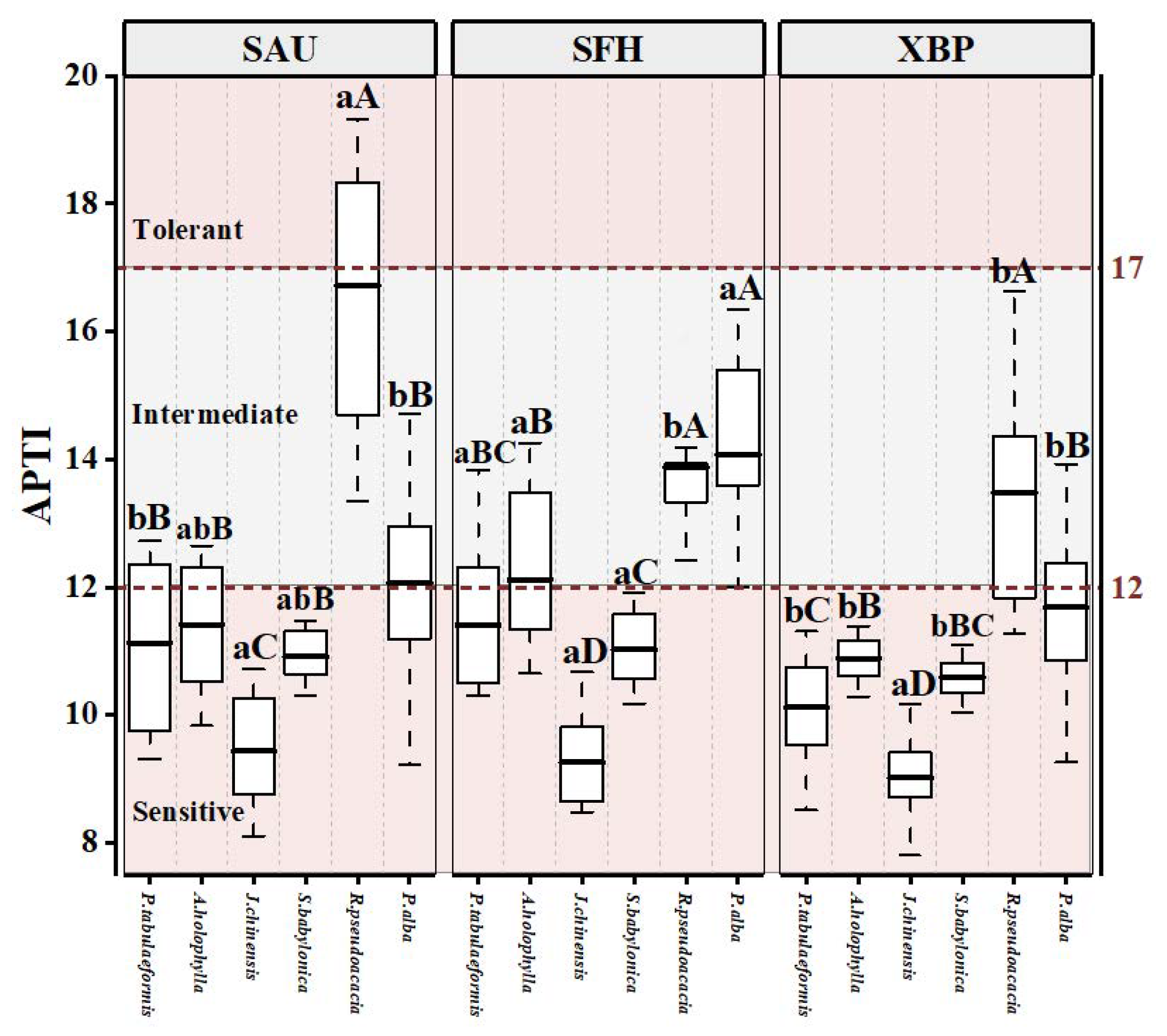
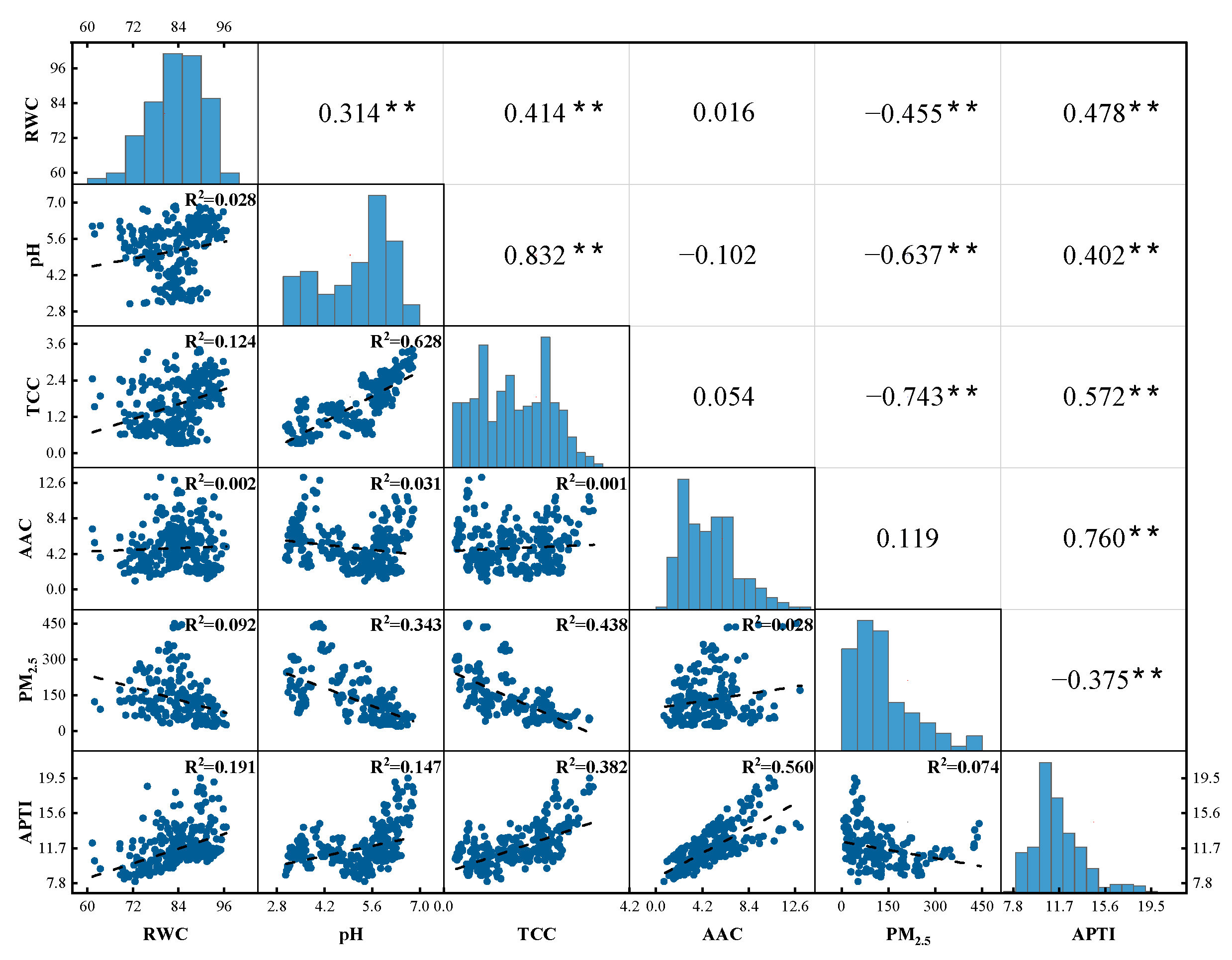

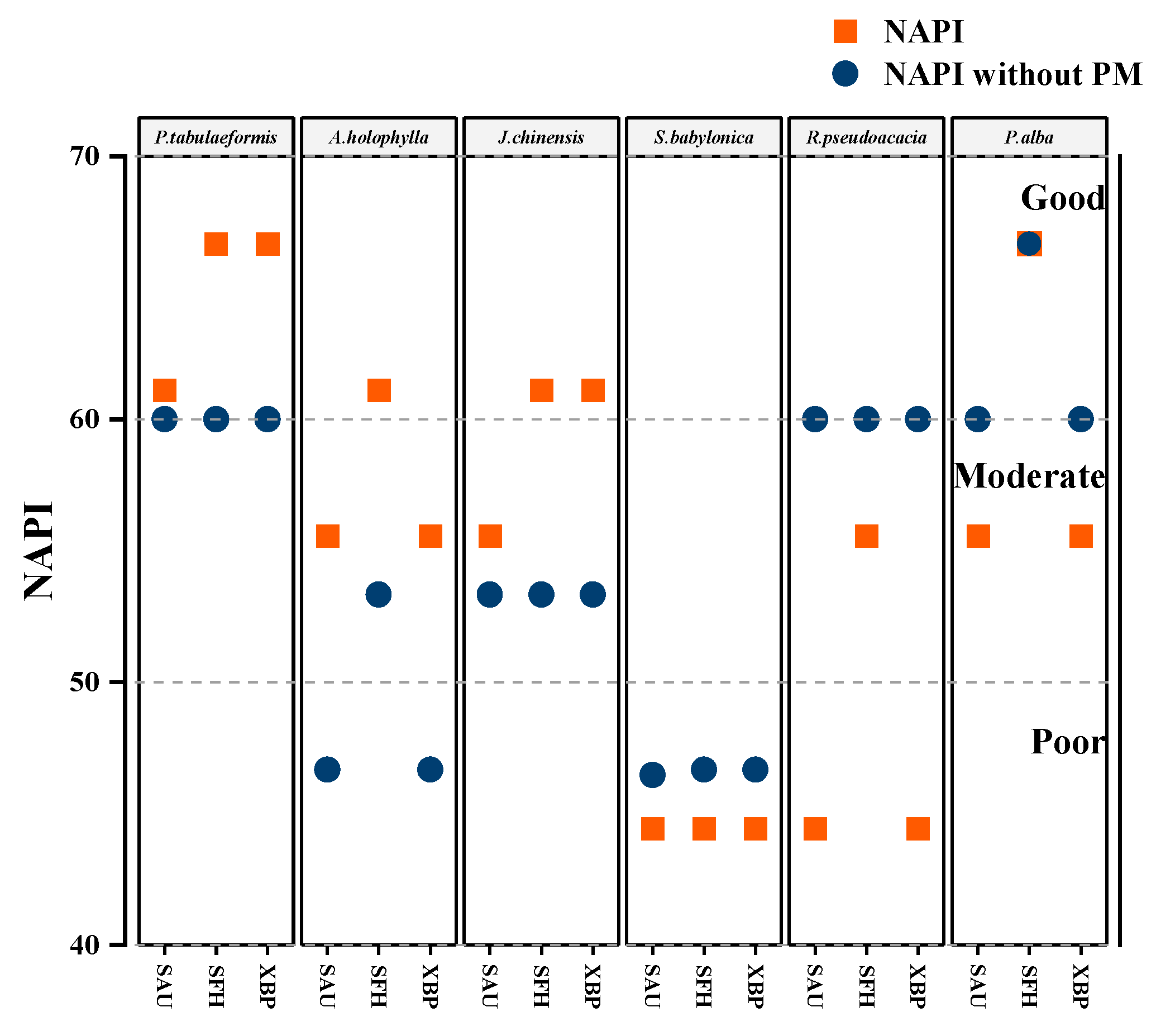
| APTI Value | Response |
|---|---|
| APTI ≥ 17 | Tolerant |
| 12 ≤ APTI < 17 | Intermediate |
| APTI < 12 | Sensitive |
| Grading | Characters Assessed | Pattern of Assessment | Grade | |
|---|---|---|---|---|
| Tolerance | APTI | <7.0 | − | |
| 7.0–12.0 | + | |||
| 12.0–17.0 | ++ | |||
| >17.0 | +++ | |||
| Ecological benefits | PM2.5 capture ability | 0–50 μg·cm−2 | − | |
| 50–100 μg·cm−2 | + | |||
| 100–150 μg·cm−2 | ++ | |||
| ≥150 | +++ | |||
| Biological characteristics | Plant habit | Small | − | |
| Medium | + | |||
| Large | ++ | |||
| Canopy structure | Sparse | − | ||
| Semi-dense | + | |||
| Spreading dense | ++ | |||
| Type of plant | Deciduous | − | ||
| Evergreen | + | |||
| Laminar structure | Leaf size | Small | − | |
| Medium | + | |||
| Large | ++ | |||
| Hardiness | Low | − | ||
| Hardy | + | |||
| Growing condition | Poor | − | ||
| Moderate | + | |||
| Good | ++ | |||
| Socio-economic | Economic value | <3 uses | − | |
| 3–4 uses | + | |||
| 5 or more uses | ++ | |||
| Sites | Species | Roughness | Contract Angle | Stomatal Density | Groove Width |
|---|---|---|---|---|---|
| SAU | P. tabulaeformis | 321.4 ± 34.46 bA | 66.60 ± 2.04 aE | 48.73 ± 2.67 cC | 12.93 ± 0.95 aC |
| A. holophylla | 124 ± 16.09 bC | 64.32 ± 2.78 bE | 66.16 ± 3.23 cB | 15.7 ± 0.90 bA | |
| J. chinensis | 180.75 ± 10.59 cB | 96.41 ± 5.16 bD | 34.27 ± 6.60 cD | 15.3 ± 1.71 aAB | |
| S. babylonica | 75.47 ± 4.78 bD | 112.49 ± 0.91 aB | 136.61 ± 13.44 aA | 14.11 ± 1.38 aABC | |
| R. pseudoacacia | 93.11 ± 2.27 bD | 133.04 ± 2.54 aA | 147.81 ± 14.86 bA | 13.42 ± 0.75 aBC | |
| P. alba | 116.55 ± 6.49 bC | 109.28 ± 1.27 aC | 138.58 ± 20.34 bA | 7.81 ± 0.65 bD | |
| SFH | P. tabulaeformis | 376.20 ± 20.25 aA | 68.23 ± 4.50 aD | 68.28 ± 7.73 bB | 11.49 ± 1.72 bCD |
| A. holophylla | 146.40 ± 12.10 aB | 63.90 ± 6.47 bD | 75.25 ± 5.18 bB | 17.44 ± 1.68 aA | |
| J. chinensis | 327.20 ± 23.30 bA | 106.39 ± 1.21 aC | 47.02 ± 6.54 bC | 15.08 ± 0.95 aB | |
| S. babylonica | 81.39 ± 6.35 bD | 111.91 ± 0.20 aB | 147.26 ± 14.14 aA | 12.36 ± 0.97 bC | |
| R. pseudoacacia | 110.50 ± 11.63 aC | 127.22 ± 1.45 bA | 166.46 ± 24.42 bA | 10.62 ± 0.58 bD | |
| P. alba | 135.55 ± 3.23 aBC | 107.52 ± 5.26 aBC | 141.14 ± 5.81 bA | 8.65 ± 0.67 aE | |
| XBP | P. tabulaeformis | 410.60 ± 20.11 aA | 68.84 ± 5.78 aD | 100.45 ± 6.11 aC | 12.56 ± 0.63 abB |
| A. holophylla | 138.20 ± 12.38 abB | 76.31 ± 9.06 aD | 104.25 ± 10.34 aC | 16.96 ± 1.73 abA | |
| J. chinensis | 387.40 ± 25.41 aA | 106.36 ± 3.37 aB | 61.64 ± 11.54 aD | 14.62 ± 1.14 aA | |
| S. babylonica | 110.88 ± 4.72 aC | 104.73 ± 1.25 bB | 137.94 ± 18.24 aB | 15 ± 0.99 aA | |
| R. pseudoacacia | 118.23 ± 3.13 aBC | 124.8 ± 4.02 bA | 194.9 ± 11.58 aA | 12.77 ± 0.73 aB | |
| P. alba | 131.72 ± 13.94 aBC | 96.61 ± 3.92 bC | 183.62 ± 17.67 aA | 8.48 ± 0.53 abD |
Disclaimer/Publisher’s Note: The statements, opinions and data contained in all publications are solely those of the individual author(s) and contributor(s) and not of MDPI and/or the editor(s). MDPI and/or the editor(s) disclaim responsibility for any injury to people or property resulting from any ideas, methods, instructions or products referred to in the content. |
© 2023 by the authors. Licensee MDPI, Basel, Switzerland. This article is an open access article distributed under the terms and conditions of the Creative Commons Attribution (CC BY) license (https://creativecommons.org/licenses/by/4.0/).
Share and Cite
Li, M.; Tan, P.; Rai, P.K.; Li, Y.; Meng, H.; Zhang, T.; Zhang, Z.; Zhang, W. Suitability Assessment of Six Tree Species through Combined Analysis of PM2.5 Capture Ability and Air Pollution Tolerance Index for Urban Green Belt. Sustainability 2023, 15, 14744. https://doi.org/10.3390/su152014744
Li M, Tan P, Rai PK, Li Y, Meng H, Zhang T, Zhang Z, Zhang W. Suitability Assessment of Six Tree Species through Combined Analysis of PM2.5 Capture Ability and Air Pollution Tolerance Index for Urban Green Belt. Sustainability. 2023; 15(20):14744. https://doi.org/10.3390/su152014744
Chicago/Turabian StyleLi, Muni, Peng Tan, Prabhat Kumar Rai, Yu Li, Huan Meng, Tong Zhang, Zhi Zhang, and Weikang Zhang. 2023. "Suitability Assessment of Six Tree Species through Combined Analysis of PM2.5 Capture Ability and Air Pollution Tolerance Index for Urban Green Belt" Sustainability 15, no. 20: 14744. https://doi.org/10.3390/su152014744
APA StyleLi, M., Tan, P., Rai, P. K., Li, Y., Meng, H., Zhang, T., Zhang, Z., & Zhang, W. (2023). Suitability Assessment of Six Tree Species through Combined Analysis of PM2.5 Capture Ability and Air Pollution Tolerance Index for Urban Green Belt. Sustainability, 15(20), 14744. https://doi.org/10.3390/su152014744






